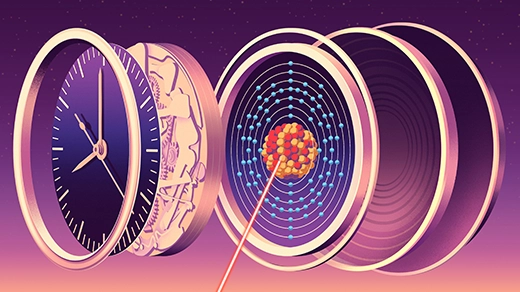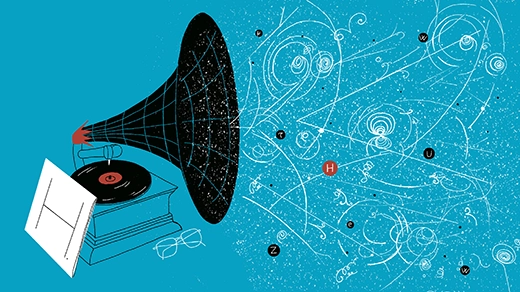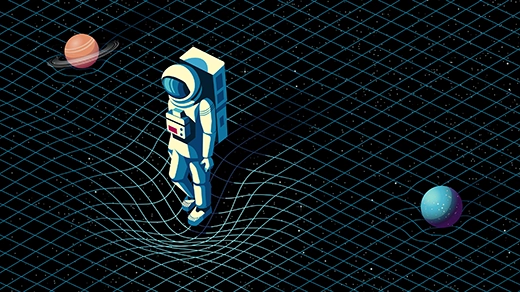The Double Life of Black Holes

James O’Brien for Quanta Magazine
Introduction
There are astrophysical black holes, and then there are mathematical ones. Astrophysical black holes sit in galactic centers, emit jets of hot plasma, and on occasion swallow stars. You have heard of those. Mathematical black holes, on the other hand, serve as the focus of physicists’ thought experiments. They are not formed from collapsing stars, they have existed forever, and they sit in an empty universe. They may be infinitely large, have perfect mirrors around them, or extend into six dimensions of space. You have heard of those too, but maybe you didn’t notice.
The story of black holes began in 1916, when Karl Schwarzschild discovered a solution to Einstein’s equations of general relativity that is able to trap light. The characteristic property of Schwarzschild’s black hole — and of all black holes discovered later — is the presence of an “event horizon,” the surface of a region from within which nothing can escape. Once you cross an event horizon, you are trapped forever.
Initially, physicists thought of Schwarzschild’s finding as a theoretical curiosity, a purely mathematical possibility that would not occur in nature. But in 1935, Subrahmanyan Chandrasekhar showed that when a big star runs out of nuclear fuel, its pressure is insufficient to counteract the gravitational pull. In this case, nothing can prevent the star from collapsing to a black hole. With Chandrasekhar, black holes became a scientific possibility.
Still, physicists largely ignored black holes, believing that making one would require a carefully tuned setup, and that realistic circumstances would not lead to an unstoppable gravitational collapse. However, the very opposite turned out to be the case. In the 1960s, Stephen Hawking and Roger Penrose proved that black holes can be created in stellar collapse under quite general circumstances. That a massive, burned-out star forms a black hole, their calculations showed, is the norm, not the exception.
Indeed, in the mid-1990s, observations from the center of our Milky Way revealed an object (Sagittarius A*) for which no other explanation than a black hole seemed plausible. And in the past 20 years, evidence for black holes has become overwhelming. Astrophysicists discovered that not only our own galaxy, but most galaxies, harbor them. Black holes have been seen to eat gas and stars and to act as gravitational lenses. Their existence is no longer controversial.
Meanwhile, black holes developed a second life. In 1972, Jakob Bekenstein discovered that a black hole’s surface area corresponds to an entropy, a quantity usually associated with gases. This remarkable connection between thermodynamics and gravity tightened when, in 1974, Stephen Hawking derived that black holes have temperature and evaporate.
Hawking’s finding that black holes evaporate caused theoretical physicists quite a headache. That’s because the radiation that black holes emit does not contain information. So if a black hole collapses and then entirely evaporates, it looks like the information it contained was destroyed. This, however, would be incompatible with quantum theory, according to which information must be preserved.
This “black hole information problem” is for now a purely mathematical conundrum, because the temperature of astrophysical black holes is far too small to be observable. Real black holes will not evaporate until hundreds of billions of years into the future. But theoretical physicists think that solving the information problem will help them understand the quantum properties of space and time, and therefore allow them to find a theory of “quantum gravity.” Solving the black hole information problem is one of the benchmarks that a theory of quantum gravity must pass.
Since we cannot study black holes in a laboratory, theoreticians have used thought experiments to understand the fate of a particle that crosses the horizon. These thought experiments are highly abstract. The observers don’t have mass. The detectors don’t need calibration. The black holes don’t have gas swirling around them. In such idealized situations, theoreticians have tried to calculate what happens to a single quantum of information that falls into a black hole. From this they learned that black holes are adept information jugglers, able to distribute and scramble bits more efficiently than any other known system.
The mathematics is rich and has delivered surprising insights. For example, Einstein’s theory of general relativity can be used in any number of dimensions of space. And theoreticians have found that the higher the number of dimensions, the more types of black holes there are. In three dimensions of space, we have only spherical black holes. In four or more dimensions of space, however, we could have ring-shaped black holes. We could also have black rods, or multiple disconnected horizons, such as several rings, or rings around spheres — “black Saturns.”
String theorists moreover like to study black holes in universes with a negative cosmological constant (the so-called Anti-de Sitter spaces). Our actual universe has a positive cosmological constant. But if the cosmological constant is negative, black hole horizons can be infinitely extended planes. In addition to higher dimensions and a negative cosmological constant, theoreticians also prefer black holes that have existed forever, and they balance the mass-loss from radiation by assuming that an equal amount of matter falls in.
These are highly abstract situations that we will never observe in the real universe. But theoretical physicists think that looking at mathematical black holes in spaces with a negative cosmological constant may have benefits in areas other than astrophysics. As consequence of a conjecture put forward by Juan Maldacena in 1997, the mathematics of black holes in such spaces may describe collections of particles that interact strongly.
This is how you might have heard of mathematical black holes: They are a string theorist’s way of modeling the behavior of quark-gluon plasmas or “strange” metals (called “strange” because they are difficult to make sense of with the common mathematical treatments). In more recent developments, mathematical black holes have been employed to study chaos and complexity in certain quantum systems. Whether those calculations will result in useful predictions remains to be seen. But they have undoubtedly added new tools to the mathematical tool kit, and who knows, maybe one day we’ll find a nail for the hammer.
Mathematical black holes have allowed theoretical physicists to find links between areas of their discipline once thought to be largely disconnected: thermodynamics, gravity, quantum information and condensed matter physics. Those insights may help to develop a theory of quantum gravity, or give rise to new methods to predict the behavior of certain fluids. But this research is largely disconnected from the astrophysical study of black holes — questions about their formation, distribution, their jets and how they merge. In other words, the question of how to explain observations.




